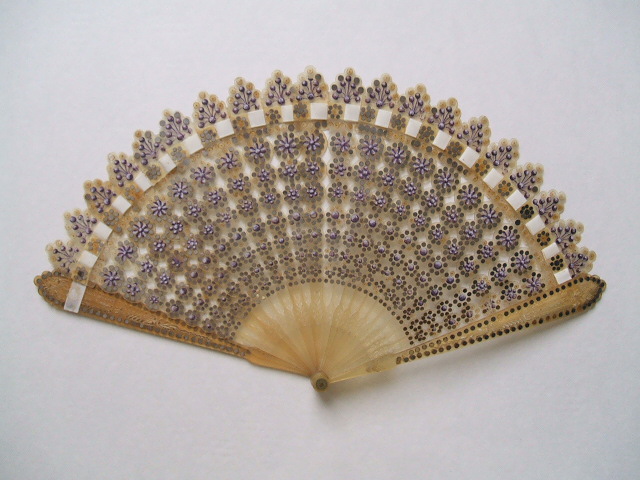The most common fan in the 18th Century was the folding variety based on Chinese models. Unlike their Asian counterparts, however, European fans had elaborately carved and decorated sticks, made of ivory, mother-of-pearl, horn, wood, and tortoise shell. Fan leaves were made of vellum and paper and were both hand painted and printed.
A Vernis Martin fan of the early Eighteenth Century.
In 1709, Sir Richard Steele commented in The Tatler that "the fan is the armour of women" and "the men's minds are constructed by the waving of that little instrument...our thoughts in composure or agitation according to the motion of it".
The language of the fan could be understood by both sexes and was an important means of communication. A quick gesture conveyed a silent message that could escape the attention of a chaperone or a jealous spouse. Thus, drawing the fan across your left cheek indicated 'I love you' or letting it rest on the right cheek meant 'yes'. Touching the tip of the fan with one finger meant 'I wish to talk to you' but holding the closed fan with your little finger extended meant 'goodbye'. There is a long list of what the various gestures mean - no wonder the gentlemen were in 'composure or agitation' at social gatherings as they sought to decide their ladies' mood on that evening.
 It was considered acceptable for a gentleman to offer a fan as a gift to a lady, perhaps at Christmastime. Many of these were works of art, with pierced and gilded ivory or mother of pearl sticks and guards, and delicately painted leaves of paper, embroidered muslin or lace.
It was considered acceptable for a gentleman to offer a fan as a gift to a lady, perhaps at Christmastime. Many of these were works of art, with pierced and gilded ivory or mother of pearl sticks and guards, and delicately painted leaves of paper, embroidered muslin or lace.
Click on this link : The language of the Fan 
to be taken to a charming video on the language of the fan by
author Brandy Vallance

Blond horn brisé hand fan with steel dots applied. It is a typical exemple
of the early decades of 19th century.
